
by Terri Keith | Feb 21, 2021
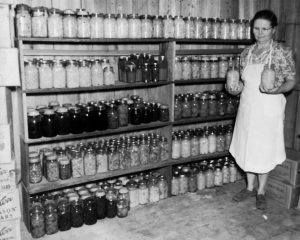
Homemade canned preserves 1942.
Photo Credits: UF/IFAS File Photo
In 1795, Napoleon needed a better way to preserve large quantities of food for his troops during the Napoleonic Wars, so his government offered a reward of 12,000 francs for the invention of a new food preservation method. In 1809, Nicolas Appert won that award with his canning technique that used glass containers that were sealed then heated to a set temperature. Peter Durand created the tin canister a year later. These inventions led to the canning materials and processes that are used today to preserve food for people all over the world.
Canned food provides a convenient and often less expensive way to include fruits and vegetables in the diet of many individuals and families. Canned foods are also considered a staple in many pantries because of their shelf life. Commercially canned products may keep the food packed inside at its best quality for 1 to 5 years depending on the type of food. Most home canned foods are able to be stored for up to a year, though there are some exceptions.

Photo Credit: UF/IFAS Photo by Tyler Jones
To make the most of canned foods, keep these tips in mind.
Best by or use by dates on commercial products do not indicate safety. They are estimated dates provided by the manufacturer on how long they believe their product would be at its best quality. The exception to this is for infant formula products that are required to have a “Use-By” date and should not be used after that date.
Avoid cans or jars that are not in good condition. Look for dents, swelling or bulging, leaking, rust, cracks in jars or loose lids. If the food has a foul odor or spurts liquid when it’s opened, do not use it. Any of these could indicate the food may have been contaminated or could contain Clostridium botulinum toxins.
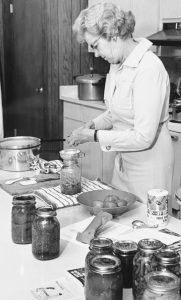
A woman canning in the kitchen.
Photo Credits: UF/IFAS File Photo
Store canned foods in a cool, dark and dry space. This will help them to last longer and keep the food inside at its best quality. Keep canned foods in an area that is between 50-70°F.
Use canned foods to fill nutrition gaps. Add a can of vegetables to your dinner menu—a side of green beans or carrots can help balance your plate. Try using a can of fruit as a basis for a dessert. Pineapple and cottage cheese, anyone? If you’re concerned about sodium or sugar in canned foods, look for products marked as low sodium or lite for less sugar. Compare ingredient and nutrition labels of different brands or varieties of a product to find what works best for you.
If you can foods at home, make sure you’re following recipes that have been tested for safety. Follow the guidelines in the USDA Complete Guide to Home Canning, 2015 Revision or find more information at the National Center for Home Food Preservation. You can also contact your local extension office; in Florida, you can find your local office here.
Resources:
U.S. Department of Agriculture, National Agricultural Library, How Did We Can?: https://www.nal.usda.gov/exhibits/ipd/canning/timeline-table
U.S. Department of Agriculture, AskUSDA, How long can you keep canned goods?: https://ask.usda.gov/s/article/How-long-can-you-keep-canned-goods
U.S. Department of Agriculture, Food Safety and Inspection Service, Food Product Dating: https://www.fsis.usda.gov/wps/portal/fsis/topics/food-safety-education/get-answers/food-safety-fact-sheets/food-labeling/food-product-dating/food-product-dating
by Kendra Hughson | Feb 1, 2021
In the midst of the COVID-19 pandemic, many of us have turned to cooking more meals at home. Cooking meals and eating at home has many benefits. When preparing meals, you can select the ingredients and choose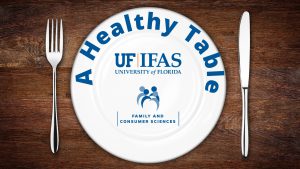 healthy recipes lower in saturated fats, sodium, and sugar. When eating out, we tend to eat more food. You can more easily control your portion sizes when eating at home. Remember to include a variety of fruits and vegetables in your main dishes and side dishes. Finally, preparing and eating meals together is not only a fun way to teach healthy eating habits and cooking skills, but it is also a great way to connect with each other at the end of the day.
healthy recipes lower in saturated fats, sodium, and sugar. When eating out, we tend to eat more food. You can more easily control your portion sizes when eating at home. Remember to include a variety of fruits and vegetables in your main dishes and side dishes. Finally, preparing and eating meals together is not only a fun way to teach healthy eating habits and cooking skills, but it is also a great way to connect with each other at the end of the day.
We invite you to join us for A Healthy Table: Virtual Cooking School. In our virtual cooking school, you will learn how to prepare healthy meals for your family through self-paced online lessons and hands-on cooking activities. You will have opportunities to engage in monthly live virtual cooking demonstrations and interactive learning experiences.
Register before February 9th and save 20% off the ticket price. Early registrants gain access to a bonus class and kick-off event. Tickets are on sale for $19.99 until February 9th and $25 thereafter. Registration will close on February 23. Once registered, you will receive the Zoom class link and the link to the class website. Register here: http://bit.ly/ahealthytable.
The monthly Zoom class events will be held from 6:30-7:30 pm CT/ 7:30-8:30 pm ET on:
- Tuesday, February 9th: Kickoff Event Available for Early Birds only Program introduction and a sweet, healthy treat demonstration.
- Tuesday, February 23rd: Lesson 1, Kitchen skills primer
- Tuesday, March 23rd: Lesson 2, Cooking techniques – baking, grilling, roasting
- Tuesday, April 27th: Lesson3, Simple dishes – eggs, breads, salads, pasta
- Tuesday, May 25th: Lesson4, One dish meals – one-pot, slow cooker, packet meals
- Tuesday, June 22nd: Lesson 5, Entertaining and special occasions – setting a table, appetizers
Come cook with us and set your table for better health.
References:
Benefits of Cooking at Home
Cooking at Home for Healthier Eating
Benefits of Family Meals

by Terri Keith | Jan 14, 2021
Setting a New Year’s resolution is a tradition for many people. Unfortunately, breaking those resolutions also seems to be a tradition. If your New Year’s resolution is to eat healthier, here are some tips to help you to be successful.
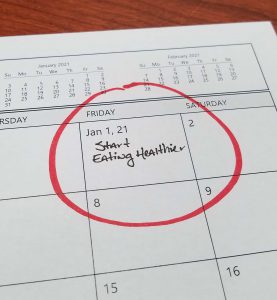
Photo Credit: Terri Keith, UF/IFAS Extension
First, you will be more likely to follow through on your resolution by setting a SMART goal. A SMART goal is one that is Specific, Measurable, Achievable, Relevant and Timed. You can find more information on setting a SMART goal here.
Second, know that eating healthier doesn’t necessarily mean going on a diet or avoiding all the foods you enjoy. Eating healthier can start with making simple substitutions to your favorite recipes, like using whole wheat pasta instead of refined grain pasta, or swapping out sodas and energy drinks for water or other unsweetened beverages. It could mean that you make a conscious effort to enjoy the foods that aren’t as healthy for you in moderation or work on lowering the amount of sodium/salt that you eat. There are many ways to eat healthier and if you need more suggestions, you can check out this article on 5 things to avoid eating.
Whether you are starting with simple steps or looking for more in-depth information, ChooseMyPlate from the USDA can be a useful resource. There, you can find information on daily recommended values for the different food groups, what counts as a serving, along with other resources, like recipes or healthy eating on a budget. You might be surprised to find out what counts as a serving!
Third, try involving your kids or other members of your household in working together to eat healthier. There’s even a section at ChooseMyPlate that focuses on healthier eating for families. It can be harder to stick with your resolution if you are the only one working on it because your shopping list can end up including more sweetened snacks than fruits and vegetables. If you need some inspiration to get started, you can find a few videos of recipes that were adapted from ChooseMyPlate here.
Eating healthier is a terrific goal any time of the year. If this is your New Year’s resolution, follow these tips and stick with it!

by Melanie Taylor | Nov 24, 2020
2020 has been a year of many changes and challenges due to the Coronavirus pandemic, which unfortunately will continue into our holiday season. To protect our friends, family and community members we must continue following the science-based guidelines provided by the Centers for Disease Control and Prevention (CDC) and your state and local guidelines to prevent exposure and the spread of the virus.
Unfortunately, the Covid-19 epidemic numbers are rising again. Gatherings of any kind, both small and large, are contributing to the rise in positive cases. We can all make choices based on the scientific research that can protect us and others by making small changes in our 2020 holiday celebrations. Limiting the risk and being diligent in our actions should be our main goal until a vaccine is approved and dispersed throughout the country.

Holiday Dinner
Photo Source: UF/IFAS
Some unique and easy ways to celebrate the holidays this year are to “gather virtually” with those not in your immediate household or to gather in-person only with members of your own household. These two types of gatherings offer the lowest risk for spreading the virus. Your household is anyone who currently lives and shares common spaces in your home. People who do not currently live in your home, such as college students who are returning home from school for the holidays, should be considered part of different households. In-person gatherings that bring together family members or friends from different households, including those college students returning home, offer varying levels of risk. The level of risk is difficult to determine because people may have been exposed and/or are a carrier and may not be aware of it.
Here are some specific things to consider when deciding how to celebrate your holidays.
- Number of cases in your community – Be sure to know the number of positive Covid cases in your community. If the numbers are rising or are already high you should take precautions based on the data. You can check your specific county or city Covid rates at your local health departments website.
- Exposure during travel – Airports, bus stations, train stations, public transport, gas stations, rest stops and hotels are all places travelers can be exposed to the virus in the air and on surfaces. Be aware if you will be traveling or if you have guests traveling to your home.
- Location of your gathering – Indoor gatherings, especially those with poor ventilation, expose your family to more risk than outdoor gatherings.
- How long will your gathering last? – Time is an important factor to consider. The longer the gathering lasts the more risk those attendees will have of being exposed. Being within 6 feet of someone who has Covid for a cumulative total of 15 minutes or more greatly increases the risk of becoming sick and requires a 14-day quarantine.
- Number and crowding of people at the gathering – Gatherings with more people bring more risk than gatherings with fewer people. The size of a holiday gathering should be determined based on the ability of attendees from different households to stay 6 feet (2 arm lengths) apart, wear masks, wash hands and follow state, local, territorial, or tribal health and safety laws, rules and regulations.
- Behaviors of attendees before the gathering – People who do not consistently follow social distancing, wearing masks, regular handwashing and other prevention behaviors cause more risk than those who consistently practice the recommended safety measures.
- Behaviors of attendees during the gathering – Gatherings with more safety measures in place, such as mask wearing, social distancing and handwashing, offer less risk than gatherings where fewer or no preventive measures are being implemented. Use of alcohol or drugs may alter judgment and may make it more difficult to practice Covid safety measures.

Be sure your technology is charged and ready for your virtual holiday visit. Photo Source: Kendra Zamojski
Other high-risk holiday related activities to avoid to help prevent the spread of the virus:
- Going shopping in crowded stores.
- Participating or being a spectator at a crowded parade, race or other holiday celebration.
- Attending large indoor gatherings with people from outside of your household.
- Using alcohol or drugs that may alter judgment and make it more difficult to practice Covid safety measures.
Things to consider before your gatherings:
To make the holiday less stressful be sure to practice a virtual session before the virtual holiday gathering. Make sure everyone involved knows how to connect to the virtual holiday celebration so the gathering will go more smoothly and hopefully experience less technical problems on that day.
We all had to adapt to many unexpected changes this year and the holidays will be no different. Just remember being diligent now will protect family and friends and help control the spread of the virus in our communities. Be sure to enjoy your unique holiday season this year, but here’s hoping for a less challenging 2021.
Stay safe! Enjoy your family and friends from a safe distance! Happy Holidays!
Source:
CDC: https://www.cdc.gov/coronavirus/2019-ncov/daily-life-coping/holidays.html

by Angela Hinkle | Nov 23, 2020
Dining out with family was the thing to do when we were so busy doing so much outside the home. Now that we’re spending more time at home together, dining in is in again. You can start or continue the “in” thing by taking the pledge to dine-in healthy with your family this December 3rd. Why take this kind of pledge? Keep reading.
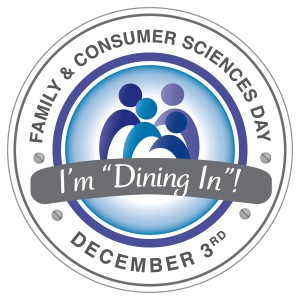
FCS Dine In Day
Making and keeping a promise has an upside
Keeping the commitment you made to eat healthy with your family means you get to reap the rewards of actually providing a healthy meal for your family. Additionally, keeping this promise can boost your self-confidence and self-esteem because you know you’re making strides to take care of yourself and your family.
Become popular
Since dining in is in again, eating healthy with your family December 3rd makes you the admired one to your family and friends. As you dine in together, share praises and compliments as well as healthy foods, and reinforce the feeling of belonging. After providing these trendy experiences often enough, you can begin to enjoy the adoration and respect of others around you. You can be popular.
It’s cherished time
Schedule it. Block off time for it. Show up for it. You and your family are worth it. Start with the pledge on December 3rd. For best success for a healthy lifestyle change, make it a S.M.A.R.T. goal. That’s one that is Specific, Measurable, Attainable, Relevant, and Time-framed. Here’s an example: Every Tuesday at 6pm, our family will eat a healthy meal together that includes at least two vegetables and a whole grain.
You can keep it safe
- If ventilation indoors is a bit stifling, eat outdoors when you can. Backyards, patios, and porches are great venues for your dining experiences.
- Clean your hands often as you prepare and eat your meal. If you can’t wash for 20 seconds with soap and running water, hand sanitizer is a good backup. Make sure your hands are completely dry after washing or sanitizing.
- Cook foods to the proper temperature. See the Safe Internal Temperature Chart.
- Put leftovers away as quickly as possible.
Tried and true or something new
- Have fun. Try decorating to make your mealtime together special. Let all family members participate.
- Make comfort food. But also try making something you’ve never had before, or try food prepared in a new way.
- Look through the cabinets or in the garage for kitchen equipment you haven’t used in a long time or have forgotten you had. Then use it.
For better health and wellness, make the pledge to Dine In with your family this December 3rd. Now is the time – especially since dining in is in again.

by Samantha Kennedy | Nov 10, 2020
It has often felt like time has dragged on in 2020, but despite all the challenges, time has continued to march on, and that means the holiday season is right around the corner. Thanksgiving is fast approaching; November 26th will be here before we know it. And while this year has been tough in many ways, we also have a lot for which to be thankful.
One of the ways we celebrate that gratitude is through a nice meal with friends and family. However, many of us have experienced financial difficulties over the last several months, which may put a damper on our traditional celebrations.
With that in mind, here are a few tips for saving money this Thanksgiving:
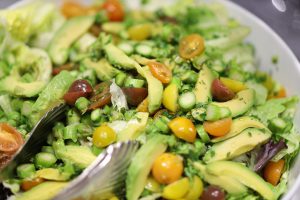
Keeping the sides simple and having guests contribute items to the meal are two ways to reduce the overall cost of a Thanksgiving meal. (Photo source: Tyler Jones, UF/IFAS)
Shop with a list. This is good advice for everyday shopping, too, but especially at the holidays, when there are just so many delicious seasonal goodies available and we might feel like splurging. Don’t get carried away, though! Stick to traditional favorites everyone enjoys and only get enough to feed the number of guests, not an army. And remember, if it’s not on the list, don’t buy it.
Shop early. Supermarkets often begin putting holiday food items on sale weeks before the main event. Planning ahead and purchasing ingredients early can save money in the long run. Also, think about purchasing canned and dry goods for next year’s festivities right after this Thanksgiving, as ingredient prices are reduced in order to sell them more quickly and make room for other items. Just remember to check the expiration/sell-by dates to make sure they do not expire before next year.
Choose one type of meat. Turkey is the traditional centerpiece to most American Thanksgiving meals, but it doesn’t have to be. Other popular meats include ham, lamb, roast, and prime rib. The key to saving money on the meat, however, is to choose just one. Meat is one of the most expensive items on a Thanksgiving menu, and, odds are, if there is an abundance of side dishes, there won’t be a need for as much meat.
Frozen over fresh. As for the turkey, go with a frozen store brand turkey. The savings could be significant over a name brand or fresh turkey. Just remember, frozen turkeys take time to thaw safely in the refrigerator. Plan for 24 hours of thawing time per five pounds of turkey. For example, a 15-pound turkey will take at least three days to thaw in the refrigerator. Remember to place the turkey in a pan to prevent juices from dripping onto other food in the refrigerator.
Make it a potluck. Ask guests to bring a dish to share with everyone else. This way, the expense is spread out over several people and everyone saves money. There are some really great free websites that allow people to sign up to bring certain items. Customizing the sign-up helps ensure that everything is accounted for and that there isn’t a pile of pumpkin pies but no side dishes.
For more information about holiday savings tips, contact Samantha Kennedy, Family and Consumer Sciences agent, at (850) 926-3931, or reach out to your local Extension office.
Additional Resources:
Five Steps to Seasonal Savings (UF/IFAS Extension)
Food Safety Tips for the Holiday Season (UF/IFAS Extension)
UF/IFAS is an Equal Opportunity Institution.













